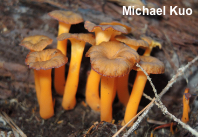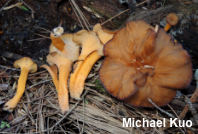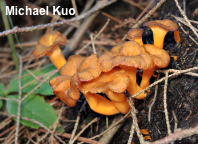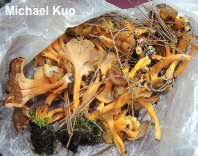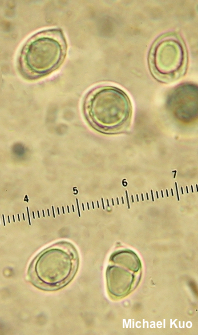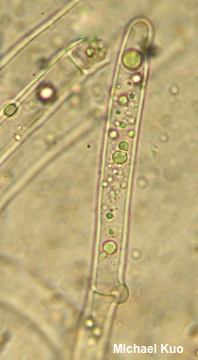| Major Groups > Chanterelles and Trumpets > Craterellus lutescens |

|
Craterellus lutescens [ Basidiomycota > Cantharellales > Cantharellaceae > Craterellus . . . ] by Michael Kuo I find this cool little mushroom in northern Michigan's cold conifer bogs, growing in wet moss on the ground and on decaying logs. It is quite distinct among the chanterelles and trumpets by virtue of its perforated brown cap, orange-yellow stem, and almost completely smooth undersurface. Similar mushrooms differ on one or more of these features: Craterellus tubaeformis and Craterellus species 02 have perforated brown caps, but feature duller stem colors and false gills on the undersurface; Craterellus ignicolor is similar in stature and stem color, but features a bright orange-yellow cap and false gills or deep and prominent wrinkles; Craterellus odoratus is deeply vase-shaped, lacking a clearly defined stem, and is orange-yellow overall; and, last but not least, Cantharellus lateritius has a fairly smooth undersurface, but is stockier and meatier, and yellow all over (and is found in dry, oak forests). Cantharellus lutescens is a synonym, as are Cantharellus/Craterellus xanthopus, luteocomus and aurora. Description: Ecology: Apparently mycorrhizal; associated with conifers in wet conifer bogs; growing gregariously, often in moss or on well-decayed, mossy logs; summer and fall; originally described from Europe; in North America distributed in the northeast, the upper Midwest, the Appalachians, and Mexico; also recorded from the Caribbean, Central America, and western Asia. The illustrated and described collection is from Michigan. Cap: 2–6 cm across; shallowly to deeply vase-shaped; bald, or with innate brown fibrils; brown to orangish brown or brownish orange; fading to tan. Undersurface: Running down the stem; smooth or slightly wrinkled; bald; pastel orangish yellow. Stem: 2.5–5.5 cm long; 4–11 mm thick; equal, or tapered slightly toward the base; hollow; bald; lubricous; bright orange; basal mycelium white. Flesh: Whitish in cap; orangish in stem cortex; insubstantial; unchanging. Odor and Taste: Not distinctive. Chemical Reactions: KOH negative on cap surface. Iron salts negative on undersurface. Spore Print: Not recorded. Microscopic Features: Spores 10–13 x 7–8 µ; subellipsoid to widely amygdaliform; smooth; hyaline in KOH, often with one large oil droplet. Basidia 50–60 x 7–9 µm; 4-sterigmate. Hymenial cystidia not found. Elements of upper surface forming a loose trichoderm; 5–10 µm wide; cylindric; septate; walls 0.5 µm thick; hyaline to brownish in KOH; terminal cells with rounded apices. Clamp connections present. REFERENCES: (Persoon, 1801) Fries, 1821. (Smith, 1968; Bigelow, 1978; Petersen, 1979; Smith, Smith & Weber, 1981; Breitenbach & Kränzlin, 1986; Phillips, 1991/2005; Barron, 1999; Vila, 2006; Nonis, 2007; Buczacki et al., 2012; Henkel et al., 2014; Gminder & Böhning, 2017; Kong et al., 2018; Læssøe & Petersen, 2019.) Herb. Kuo 08112011. This site contains no information about the edibility or toxicity of mushrooms. |
© MushroomExpert.Com |
|
Cite this page as: Kuo, M. (2020, September). Craterellus lutescens. Retrieved from the MushroomExpert.Com Web site: http://www.mushroomexpert.com/craterellus_lutescens.html |
